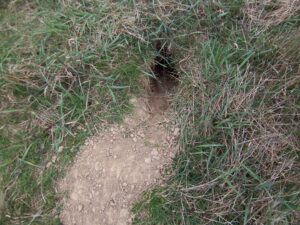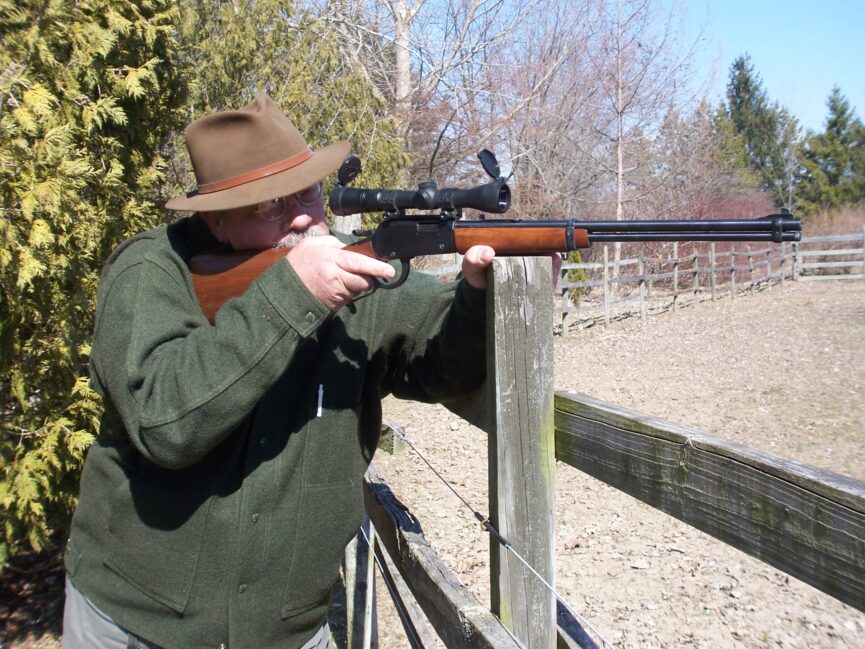
The old tongue-twister “how much wood can a woodchuck chuck” isn’t all that accurate because a woodchuck doesn’t chuck on any sort of wood, and in fact its name doesn’t relate to the woods at all. It got its official title from early English settlers who corrupted the Native American (Algonquian) name for this ground-dwelling rodent they called “wuchak”. Woodchucks actually prefer more open ground and due to the settlement process of this country that cleared forests to make way for agriculture, it would be to the woodchuck’s advantage. There is little doubt more woodchucks are here today than were ever before in this country when the Pilgrims first arrived, and I’ve heard recent comments from quite a few landowners that the woodchuck numbers are up.
The woodchuck is also called a groundhog (obviously due to its robust outline) and whistle-pig (due its piercing alarm call when it sees danger approaching). It is the largest member of the squirrel family with a typical weight of 4 to 9 pounds. Although it can climb trees when it is necessary to escape predators or get fruits and nuts or simply pan the countryside, woodchucks are distinctly designed for tunneling and living underground. They have a curved spine similar to that of moles and are quite adept in their earthy environment.
This unique tunneling and excavating process can disperse quite a bit of soil around for just one burrow and can have a detrimental effect if it is performed near and around building foundations. The burrows have been known to damage farm equipment as well, by collapsing under the weight.
I will never forget hitting and collapsing a woodchuck burrow with the front tires of my narrow-front Oliver “88” farm tractor, while brush-hogging. Yep, folks, it is an eye-opening experience which will shake the fillings in your teeth loose, not to mention causing you to see your life to flash before your eyes while desperately regaining your seat with a buzzing brush-hog right behind you. However, in a better light, the burrows offer shelter to other wildlife such as cottontail rabbits, foxes, opossums and skunks.
Several years ago, I was pheasant hunting on my farm with some friends in the prairie grass, and we were all approaching my Brittany which was on point. That is when my left foot went into an unseen woodchuck hole at an angle which sent me tumbling down, loaded shotgun and all. With hunters on each side of me and my dog directly out front, my instinctive response was in keeping the shotgun’s muzzle pointed in a safe direction, and how I landed was only a secondary consideration. I knew I had pretty much euchred my left ankle, but with it being only the latter part of October, and with a lot of hunting activities slated, I wrapped matters up tight and hobbled my way through to February, when surgery was required to repair torn ligaments.
Woodchuck burrows go about 5 feet underground and can feature some lengthy tunnels with a nest chamber and a separate toilet chamber, which are created slightly higher than the main tunnel to stay high, dry and cozy. There will be at least two and as many as five entrance holes which besides normal day to day convenience, aid in escaping danger, which is why woodchucks can be standing out in front of you, and then suddenly disappear as if by magic.
Woodchucks are true hibernators, and store up fat during the warm season to go in that very unique state (I’ve read that scientists are studying woodchucks in this regard to humans venturing into future space travel). Their winter den will be below frost level to remain above freezing temperatures for their winter sleep, and sometimes they select separate winter sites. All I can say is the woodchucks on my farm stay pretty much in the same place as they are already deep enough for anything Mother Nature will throw at them.
The woodchuck mating season is from early March until late April and the 2 to 6 young are born after a 31-32 day gestation period. The male woodchuck will be with the female until just before the young are born, and then he gets his move-out-of-the den orders. The female rears the young alone which are weaned and on their own in 5 or 6 weeks.
I’ve been woodchuck hunting since I was a farm kid and it is an outdoor pastime which has taught me a whole lot about marksmanship and shot placement, not to mention spot and stalk techniques, because woodchucks are wary and sharp-eyed critters. They are also very edible, and I have a friend with a recipe for “woodchuck stew” that will sway anybody. The key is to remove the scent glands from the “armpits” of the front legs, and any you see on the back (they are pea-sized and easy to see), otherwise they cause the meat to have a musky flavor.
Woodchucks can be hunted with center-fire rifles statewide, and a favorite round of mine is the .223. My favorite woodchuck rifle, however, is a scoped lever-action Ithaca in .22 Magnum rimfire. The fact is, many rifle caliber rounds, such as the venerable .22 Hornet, have been created with woodchuck hunting in mind, and the newer .17 caliber rimfire rounds have woodchuck hunting written all over them. This is a wonderful summer outdoor pastime to pursue, which I dearly love.
When I was a kid, I cornered a woodchuck near our barn once and I can tell you for a fact that they can go on the offensive at the get go for their size and make a grinding noise with their teeth when agitated, as well their tail-hairs stand straight up making the tail appear like a fluffed-up brush. It wasn’t a warm and fuzzy encounter at all and we soon decided to go our separate ways.
I can also remember when another kid and I were hoeing beans and a woodchuck came ditty-bopping by close to us, and the other kid ran up and unwisely drop-kicked it up into the air. The woodchuck came down, landed on all four feet facing the kid, and automatically charged full tilt. The chase was on for a spell with the kid unable to outrun the woodchuck and the woodchuck unable to catch the kid (with me, of course, laughing hysterically in the background) until the woodchuck assumed it had made its point and continued its journey on across the bean field.
I appreciate woodchucks for what they represent in nature, but I also appreciate the hunting challenge they offer during the summer months, and hunting offers an effective method to keep their blossoming numbers in check with the habitat. I’ve never had much of a problem getting a landowner’s permission to hunt woodchucks.
Yep, folks, summertime woodchuck hunting certainly works for me!
- Fickle weather during December deer hunting adventures - December 3, 2025
- Michigan’s most popular opening day – November 15th - November 23, 2025
- A missing dog found while anticipating opening day - November 23, 2025

